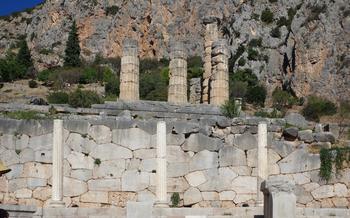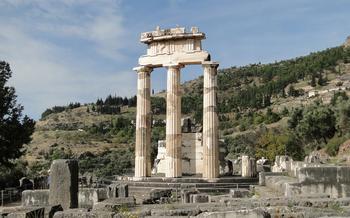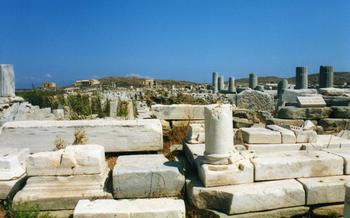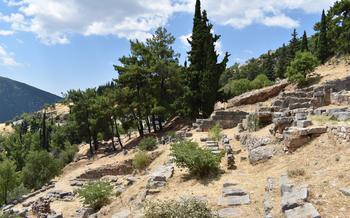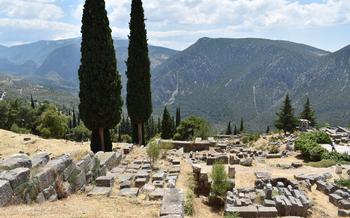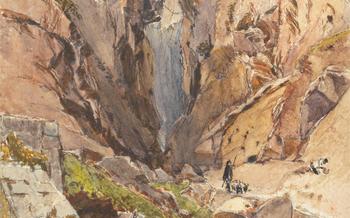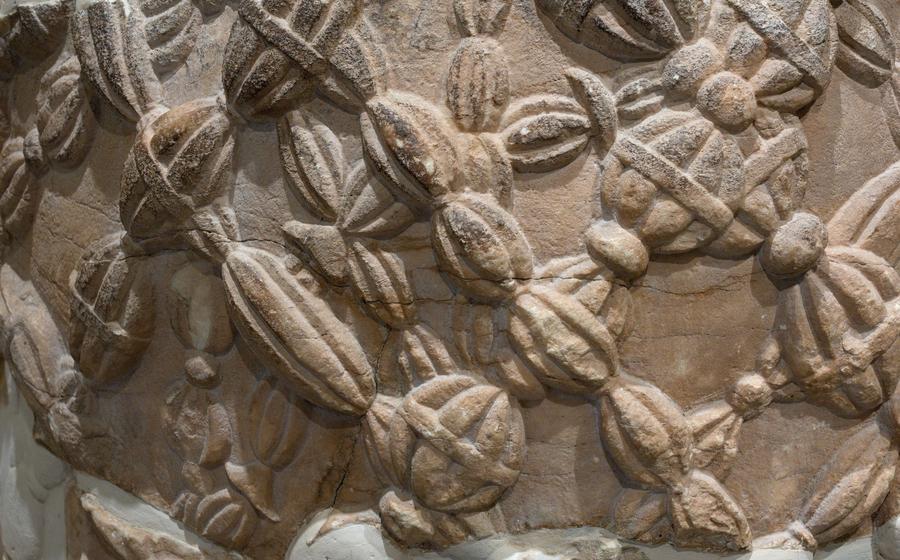
Delphi Archaeological Museum
- Delphi Archaeological Museum: A Journey Through Ancient Treasures
- Unveiling the Sphinx of Naxos: A Majestic Masterpiece
- Witnessing the Charioteer of Delphi: A Bronze Masterpiece
- Exploring the Treasury of Athens: A Testament to Athenian Power
- Immerse Yourself in the Siphnian Treasury: A Narrative in Stone
- Marvel at the Caryatid Porch: A Symbol of Feminine Grace
- Discover the Tholos of Delphi: A Monument of Circular Perfection
- Unraveling the Enigmatic Omphalos Stone: The Center of the Ancient World
- Strolling Through the Sacred Way: A Path of Ancient Pilgrimage
- Delving into the Oracle of Delphi: Unveiling the Mysteries of Prophecy
- Exploring the Stadium of Delphi: A Legacy of Ancient Athletics
- Uncovering the Archaeological Site of Delphi: A Journey Through History
- Tips for Visiting the Delphi Archaeological Museum:
- Insider Tip: Enhance Your Experience
Delphi Archaeological Museum: A Journey Through Ancient Treasures
Delphi, an ancient city steeped in mythology and history, boasts a treasure trove of archaeological wonders. Among these, the Delphi Archaeological Museum stands as a testament to the artistic and cultural achievements of ancient Greece. Located at the foot of Mount Parnassus, the museum houses a remarkable collection of artifacts excavated from the nearby archaeological site. Its exhibits provide a glimpse into the religious, political, and cultural significance of Delphi, offering visitors a journey through the annals of ancient Greek civilization.
The museum's architectural design is a blend of traditional and modern elements, creating a harmonious dialogue between the past and present. Its spacious galleries and well-curated displays showcase a vast array of sculptures, bronzes, pottery, and jewelry. These artifacts offer insights into the artistic styles, religious beliefs, and everyday life of the ancient Greeks.
The Delphi Archaeological Museum is not just a repository of ancient artifacts; it is a gateway to understanding the essence of ancient Greece. Through its exhibits, visitors can explore the rich mythology, artistic prowess, and cultural heritage that have shaped Western civilization. A visit to this museum is a journey through time, allowing visitors to connect with the spirit of ancient Greece and gain a deeper appreciation for its enduring legacy.
Unveiling the Sphinx of Naxos: A Majestic Masterpiece
Amidst the treasures of the Delphi Archaeological Museum, the Sphinx of Naxos stands as an enigmatic and awe-inspiring masterpiece. Carved from a single block of Naxian marble in the 6th century BC, this colossal statue exudes an aura of power and mystery. Its imposing presence, measuring over 2 meters in height, commands attention and invites visitors to delve into its rich history and symbolism.
The Sphinx of Naxos, with its haunting gaze and enigmatic smile, represents a creature from Greek mythology that guarded the entrance to Thebes. This mythical beast, with the body of a lion and the head of a woman, posed riddles to those who dared to approach, devouring those who failed to solve them. The Naxian Sphinx, however, wears a serene expression, suggesting a gentler interpretation of the mythical creature.
The statue's artistic style reflects the transition from the Archaic to the Classical period in ancient Greece. Its rigid posture and stylized features are characteristic of Archaic art, while the subtle modeling of the face and the delicate treatment of the drapery hint at the emerging naturalism of the Classical era. The Sphinx of Naxos thus serves as a testament to the evolving artistic sensibilities of ancient Greece.
Beyond its aesthetic significance, the Sphinx of Naxos holds deep mythological and symbolic meaning. In Greek mythology, the Sphinx was often associated with wisdom, riddles, and the power of prophecy. Its presence in Delphi, the ancient sanctuary dedicated to the god Apollo, suggests a connection between the Sphinx and the oracle of Delphi, which was renowned for its prophetic utterances.
The Sphinx of Naxos stands as a powerful reminder of the rich mythology and artistic achievements of ancient Greece. Its enigmatic presence invites visitors to contemplate the mysteries of the past and to marvel at the enduring legacy of this ancient civilization.
Witnessing the Charioteer of Delphi: A Bronze Masterpiece
In the heart of the Delphi Archaeological Museum, a bronze masterpiece stands tall, capturing the essence of ancient Greek athleticism and artistic prowess—the Charioteer of Delphi. Discovered in 1896 amidst the ruins of the Sanctuary of Apollo, this awe-inspiring statue has become an iconic symbol of Delphi and a testament to the city's rich sporting heritage.
Standing approximately 8 meters high, the Charioteer exudes an air of power and grace. Its intricate details and lifelike features showcase the exceptional craftsmanship of ancient Greek sculptors. The charioteer's muscular physique, flowing robes, and determined expression convey a sense of purpose and victory.
The statue's historical context dates back to the 5th century BC, when it was commissioned to commemorate a chariot race victory in the Pythian Games, one of the most prestigious sporting events in ancient Greece. The victory was likely achieved by a wealthy individual or city-state, who dedicated the statue as an offering to the god Apollo, patron of the games.
Beyond its historical significance, the Charioteer of Delphi holds immense artistic value. The statue's naturalistic style and attention to detail are hallmarks of the Classical period of Greek art. The charioteer's expressive face, flowing hair, and carefully rendered drapery demonstrate the sculptor's mastery of human anatomy and movement.
The Charioteer also serves as a symbol of the importance of athleticism in ancient Greek culture. Chariot racing was a highly competitive sport, requiring skill, strength, and courage. Victories in these races were celebrated with great fanfare and brought glory to the victors and their communities.
As you stand before the Charioteer of Delphi, let your imagination transport you back to the ancient stadium, filled with cheering spectators and the thunderous hooves of racing chariots. This remarkable statue embodies the spirit of athleticism, artistic excellence, and the enduring legacy of ancient Greece.
Exploring the Treasury of Athens: A Testament to Athenian Power
In the heart of the Delphi Archaeological Museum, the Treasury of Athens stands as a testament to the wealth, power, and artistic prowess of ancient Athens. Constructed in the 5th century BC, this Doric-style treasury served as a repository for the offerings and dedications made by the Athenians to the sanctuary of Apollo.
The Treasury of Athens is distinguished by its well-preserved architectural features, including its solid walls, triangular pediment, and fluted columns. The pediment, adorned with intricate sculptures, depicts scenes from the myth of Heracles and Theseus, showcasing the Athenians' deep connection to their mythical heroes.
Inside the treasury, visitors can admire a series of sculptures and decorative elements that further enhance its significance. These include statues of Apollo, Artemis, and Leto, along with intricate friezes depicting mythological scenes and historical events. The sculptures are characterized by their expressive poses, finely detailed drapery, and a harmonious composition that reflects the mastery of Athenian craftsmanship.
The Treasury of Athens served as a potent symbol of Athenian power and influence throughout the ancient world. Its strategic location within the sanctuary of Apollo, one of the most important religious centers in Greece, allowed the Athenians to showcase their wealth and devotion to the gods. The treasury's enduring legacy continues to inspire awe and admiration among visitors, offering a glimpse into the grandeur and artistry of ancient Athens.
Immerse Yourself in the Siphnian Treasury: A Narrative in Stone
Enrich your understanding of ancient Greek mythology and artistic prowess by visiting the Siphnian Treasury, a captivating structure that stands as a testament to the island of Siphnos' dedication to Apollo. Constructed in the 6th century BC, this treasury served as a repository for the offerings of the Siphnians, showcasing their wealth and devotion to the god.
As you approach the treasury, marvel at its well-preserved Doric architecture, characterized by sturdy columns and a triangular pediment adorned with intricate sculptures. These sculptures depict various mythological scenes, transporting you back in time to the realm of ancient Greek legends.
The east frieze narrates the story of the Trojan War, with heroes like Achilles, Odysseus, and Agamemnon engaged in fierce battles and strategic maneuvers. The north frieze portrays the abduction of the Leucophryenae maidens by Theseus and Pirithous, a tale of daring and audacity.
The west frieze, perhaps the most captivating, showcases the Gigantomachy, the epic struggle between the Olympian gods and the monstrous giants. Zeus, the king of the gods, hurls his thunderbolts, while Athena, the goddess of wisdom and war, valiantly charges into battle.
Each sculpture is a testament to the exceptional craftsmanship and attention to detail of ancient Greek artisans. The expressive faces, dynamic poses, and intricate drapery folds bring the mythological scenes to life, offering a glimpse into the beliefs and values of ancient Greek society.
Explore the Siphnian Treasury and let its narrative in stone captivate your imagination, transporting you to a realm where gods, heroes, and mythical creatures intertwine, shaping the rich tapestry of ancient Greek mythology.
Marvel at the Caryatid Porch: A Symbol of Feminine Grace
Amidst the ruins of Delphi, the Caryatid Porch stands as a testament to the architectural prowess and artistic brilliance of ancient Greece. This iconic structure, dating back to the 5th century BC, features a row of six graceful female figures, known as caryatids, supporting the entablature above. Each caryatid, sculpted from a single block of marble, exudes a sense of poise, strength, and elegance.
The Caryatid Porch originally served as the entrance to the treasury of the Athenians, a building that housed the city-state's offerings to the gods of Delphi. The choice of caryatids as supporting figures was a symbolic representation of the Athenian people's devotion and submission to the divine. The intricate details and harmonious proportions of the caryatids showcase the exceptional craftsmanship of ancient Greek sculptors.
The Caryatid Porch has become an enduring symbol of Delphi and ancient Greek architecture. Its depiction of women as strong and dignified figures challenges traditional gender roles and highlights the importance of feminine power and grace in ancient society. The porch continues to inspire awe and admiration among visitors, serving as a reminder of the enduring legacy of ancient Greek culture.
Discover the Tholos of Delphi: A Monument of Circular Perfection
Amidst the ruins of Delphi, the Tholos stands as a testament to ancient Greek architecture and engineering prowess. This circular structure, dating back to the 4th century BC, captivates visitors with its harmonious proportions and intricate details. Its elegant cylindrical form, composed of 20 Doric columns, rests upon a three-step crepidoma, creating a sense of stability and grandeur.
The Tholos's interior, once adorned with vibrant frescoes, reveals a circular cella surrounded by a colonnade. The roof, originally crafted from Pentelic marble, was supported by a ring of Corinthian columns, adding an element of lightness to the structure. Although the exact purpose of the Tholos remains a mystery, its architectural significance lies in its innovative design, representing a transition from traditional Greek temple architecture towards a more experimental and refined style.
Unraveling the Enigmatic Omphalos Stone: The Center of the Ancient World
Among the many treasures of the Delphi Archaeological Museum, the enigmatic Omphalos Stone stands out as a symbol of the site's profound significance in ancient Greek culture. This unassuming, yet captivating stone held a central place in the religious and mythological beliefs of the ancient Greeks.
Described as a smooth, egg-shaped stone, the Omphalos was revered as the physical center of the world. According to Greek mythology, Zeus, the king of the gods, released two eagles from opposite ends of the earth. The eagles met at Delphi, dropping a stone to mark the spot that became known as the navel, or omphalos, of the world.
The Omphalos Stone was not merely a symbolic representation; it was believed to possess divine powers. It was said to be the point where the heavens and the earth converged, a place where mortals could communicate with the gods. The stone was often used in religious rituals and ceremonies, and it was believed to have the ability to grant wishes and provide guidance to those who sought it.
The exact origin and placement of the Omphalos Stone remain shrouded in mystery. Some theories suggest that it was a natural formation, while others believe it was crafted by human hands. Regardless of its origins, the stone held a profound significance for the ancient Greeks, who regarded it as a sacred and powerful object.
Today, the Omphalos Stone can be found within the Delphi Archaeological Museum, where it continues to captivate visitors with its enigmatic presence. It serves as a testament to the rich mythology and religious beliefs of ancient Greece, reminding us of the enduring power of symbols and the human fascination with the mysteries of the world.
Strolling Through the Sacred Way: A Path of Ancient Pilgrimage
The Sacred Way, also known as the Via Sacra, was the main processional route in ancient Delphi, connecting the Sanctuary of Apollo to the Castalian Spring. Pilgrims and visitors from all over the Greek world would walk along this sacred path, lined with monuments, statues, and treasuries dedicated to various deities and heroes.
The Sacred Way was more than just a road; it was a symbolic journey that mirrored the spiritual and physical journey of those seeking guidance from the oracle. As pilgrims walked along the path, they encountered various monuments and offerings, each holding its own significance and story.
Among the notable structures along the Sacred Way were the Treasury of Athens, the Treasury of the Siphnians, and the Stoa of the Athenians, each showcasing the wealth and devotion of different city-states. Statues of gods, heroes, and mythical creatures adorned the path, creating a sense of awe and reverence.
The walk along the Sacred Way culminated at the Sanctuary of Apollo, where pilgrims would consult the oracle and seek divine guidance. The path itself became a sacred ritual, a physical manifestation of the spiritual journey undertaken by those seeking answers and wisdom from the gods.
Delving into the Oracle of Delphi: Unveiling the Mysteries of Prophecy
The Oracle of Delphi, once revered as the most renowned oracle in the ancient world, held a profound significance in Greek religious and political life. Enshrined within the Temple of Apollo, the oracle was believed to be a conduit between the mortal realm and the divine, delivering prophecies and guidance to those who sought its counsel.
Prophecies were delivered through the Pythia, a priestess chosen for her purity and piety. After undergoing elaborate rituals and inhaling sacred vapors, the Pythia would enter a trance-like state, uttering enigmatic words that were interpreted by the temple priests. These prophecies, often cryptic and open to various interpretations, influenced decisions on matters of war, peace, colonization, and personal dilemmas.
The oracle's influence extended far beyond Delphi. Kings, statesmen, and ordinary people from across the Greek world and beyond sought its guidance. Historical figures such as Croesus, king of Lydia, and the Athenian statesman Themistocles are among those who consulted the oracle before making crucial decisions.
The oracle's prestige and authority waned with the rise of Christianity and the decline of the ancient Greek world. However, its legacy remains etched in history, a testament to the enduring fascination with prophecy and the human desire to glimpse into the future.
Exploring the Stadium of Delphi: A Legacy of Ancient Athletics
Nestled amidst the foothills of Mount Parnassus, the Stadium of Delphi stands as a testament to the ancient Greeks' passion for athletics and sports. Built in the 5th century BC, this impressive structure served as a venue for the Pythian Games, one of the four major Panhellenic Games held in ancient Greece.
The stadium is a remarkable example of ancient Greek architecture, featuring a long, narrow track surrounded by sloping terraces that could accommodate up to 7,000 spectators. The starting line is marked by a row of stone blocks, while the finish line is indicated by a large stone pillar. The stadium's design allowed for a clear view of the races from all angles, ensuring that every spectator had an immersive experience.
In addition to footraces, the stadium hosted a variety of other athletic competitions, including wrestling, boxing, and pankration, a brutal combination of wrestling and boxing. The Pythian Games were not only a showcase of athletic prowess but also a celebration of the human spirit and the pursuit of excellence.
Today, visitors to the Stadium of Delphi can still sense the excitement and energy of those ancient sporting events. The stadium's well-preserved condition allows visitors to imagine themselves as spectators, cheering on their favorite athletes as they competed for glory and honor.
Uncovering the Archaeological Site of Delphi: A Journey Through History
The archaeological site of Delphi extends beyond the museum, inviting visitors to explore a treasure trove of ancient ruins and monuments. Step into the realm of history as you wander through the sacred precinct, where temples, treasuries, and other structures once stood. Discover the ruins of the Temple of Apollo, where the oracle delivered her prophecies, and admire the remains of the Athenian Treasury, a testament to the city's power and influence.
Delphi's archaeological site is a living testament to the city's rich past. Stroll along the Sacred Way, once thronged with pilgrims seeking guidance from the oracle, and marvel at the well-preserved theater, where ancient dramas and musical performances unfolded. The stadium, nestled amidst breathtaking scenery, evokes the spirit of athletic competitions held during the Pythian Games.
As you explore the site, you'll encounter remnants of various historical periods, from the Bronze Age to the Roman era. Unearth the secrets of the Mycenaean civilization, admire the architectural finesse of the Classical period, and trace the influence of Hellenistic and Roman cultures. Ongoing excavations continue to yield new discoveries, adding to our understanding of this remarkable ancient city.
Immerse yourself in the captivating history of Delphi, where every stone whispers tales of a glorious past. Let the ruins transport you back in time, as you piece together the puzzle of this sacred sanctuary that once held sway over the ancient world.
Tips for Visiting the Delphi Archaeological Museum:
When planning your visit to the Delphi Archaeological Museum, consider the following tips for a smooth and enjoyable experience:
-
Best Time to Visit: Aim for the shoulder seasons (spring and autumn) to avoid the summer crowds and intense heat. The museum offers a more relaxed atmosphere during these periods, allowing you toじっくりと explore the exhibits.
-
Guided Tours and Audio Guides: Take advantage of the guided tours or audio guides provided by the museum. These guided tours offer insightful commentary and historical context, enhancing your understanding of the artifacts and the significance of the site.
-
Accessibility: The museum is wheelchair accessible, with ramps and elevators available for visitors with disabilities. Accessible restrooms are also provided for added convenience.
-
Photography Regulations: Photography is generally permitted within the museum, but the use of flash photography is prohibited to protect the delicate artifacts. Please be mindful of these regulations when capturing your memories.
Insider Tip: Enhance Your Experience
To make your visit to Delphi even more memorable, consider venturing beyond the archaeological museum and exploring the surrounding area. The picturesque village of Arachova, situated on the slopes of Mount Parnassus, offers stunning views and traditional Greek charm. Wander through its cobbled streets, admire the local architecture, and savor delicious regional dishes at one of the many tavernas.
Delphi is also a gateway to the natural wonders of the region. Mount Parnassus, with its lush forests and majestic peaks, invites you to embark on hiking or biking trails. Discover hidden waterfalls, tranquil lakes, and breathtaking panoramas that will leave you in awe.
Indulge in the local cuisine, which showcases the freshest ingredients and traditional recipes. Sample mouthwatering dishes such as succulent grilled meats, homemade cheeses, and pastries that will tantalize your taste buds.
Throughout the year, Delphi hosts various cultural events and festivals that celebrate its rich heritage. Immerse yourself in traditional music and dance performances, witness theatrical reenactments of ancient myths, or participate in workshops and demonstrations that bring history to life. These events offer a unique opportunity to connect with the spirit of ancient Greece and create lasting memories.
